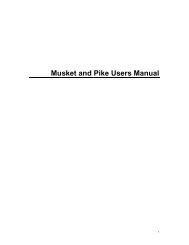Designer's note - Scenario Design Center
Designer's note - Scenario Design Center
Designer's note - Scenario Design Center
You also want an ePaper? Increase the reach of your titles
YUMPU automatically turns print PDFs into web optimized ePapers that Google loves.
city and its inhabitants. On 12th May 1949, the Soviet Union finally backed down and<br />
lifted the blockade.<br />
On 4 April 1949, NATO (North Atlantic Treaty Organization) was established with<br />
Belgium, Denmark, France, Great Britain, Iceland, Italy, Canada, Luxembourg, the<br />
Netherlands, Norway, Portugal and the United States as original members. The alliance<br />
grew in strength as Turkey and Greece joined the alliance with the Federal Republic of<br />
Germany joining in 1955.<br />
Also in 1955, the Warsaw Pact, the eastern military alliance, was formed under Soviet<br />
leadership and with the member states Albania, Bulgaria, the German Democratic<br />
Republic, Poland, Romania, Czechoslovakia, and Hungary.<br />
When the East German government built the Berlin Wall on 13.August 1961 in order to<br />
restrict the Western Powers’ freedom of movement in East Berlin, the situation escalated<br />
dramatically<br />
.<br />
On 22 October 1961, the American diplomat Lightner was initially refused entry to East<br />
Berlin and was granted passage only after massive US pressure. On 27 October, ten<br />
Soviet tanks blocked the American entry point to East Berlin, Checkpoint Charlie. The<br />
US responded with ten of their own tanks. The world held its breath during this<br />
super-power confrontation. After 16 hours under the shadow of nuclear war, President<br />
John F. Kennedy arranged a diplomatic solution and both sides stood down.<br />
The ultimate crisis of the Cold War occurred in October 1962 when the US blockaded<br />
Cuba to prevent the stationing of Soviet missiles there. After thirteen breathless days, the<br />
Russians withdrew their SS-4 missiles.<br />
With the end of the Vietnam War, a phase of relaxation of tension occurred and<br />
disarmament negotiations began between the two Blocks. First disarmament contracts<br />
like SALT I (Strategic arm's Limitation Treaty) and SALT II were concluded, followed by<br />
the conference on security and cooperation in Europe. Peace negotiation shaped this<br />
epoch.<br />
Ib. Why in 1985?<br />
Most of you surely wonder why we selected 1985 as a year of conflict. We chose this year<br />
because it marked the introduction of different weapon systems within the NATO and the<br />
Warsaw Pact. Beginning in the 80’s the USA fielded the M1 Abrams, for example, the<br />
Germans their Leopard II, and the Soviet Union the T-80 tank. A certain time is required to<br />
deliver new equipment to the troops and to replace older models. Also the team and I had<br />
very good book sources about this time period, so why not use it. One funny thing by the<br />
way, as I walked through the local library back in November, I stumbled across a book<br />
which looked promising at first look, so I took it back home. After reading the introduction I<br />
discovered it was written by an East German author and printed by the East German<br />
government. Everything was there, NATO structure, Division/Brigade structure, equipment<br />
from tanks, aircraft, ships to light weapons, very detailed battlefield tactics and so on.<br />
Checking back with army members of the Fulda Gap team, we found out the information<br />
within the book was very accurate. Scary when you imagine this book was made for the<br />
public and what secret information the Warsaw Pact knew!<br />
Page 8




